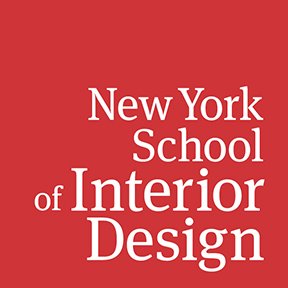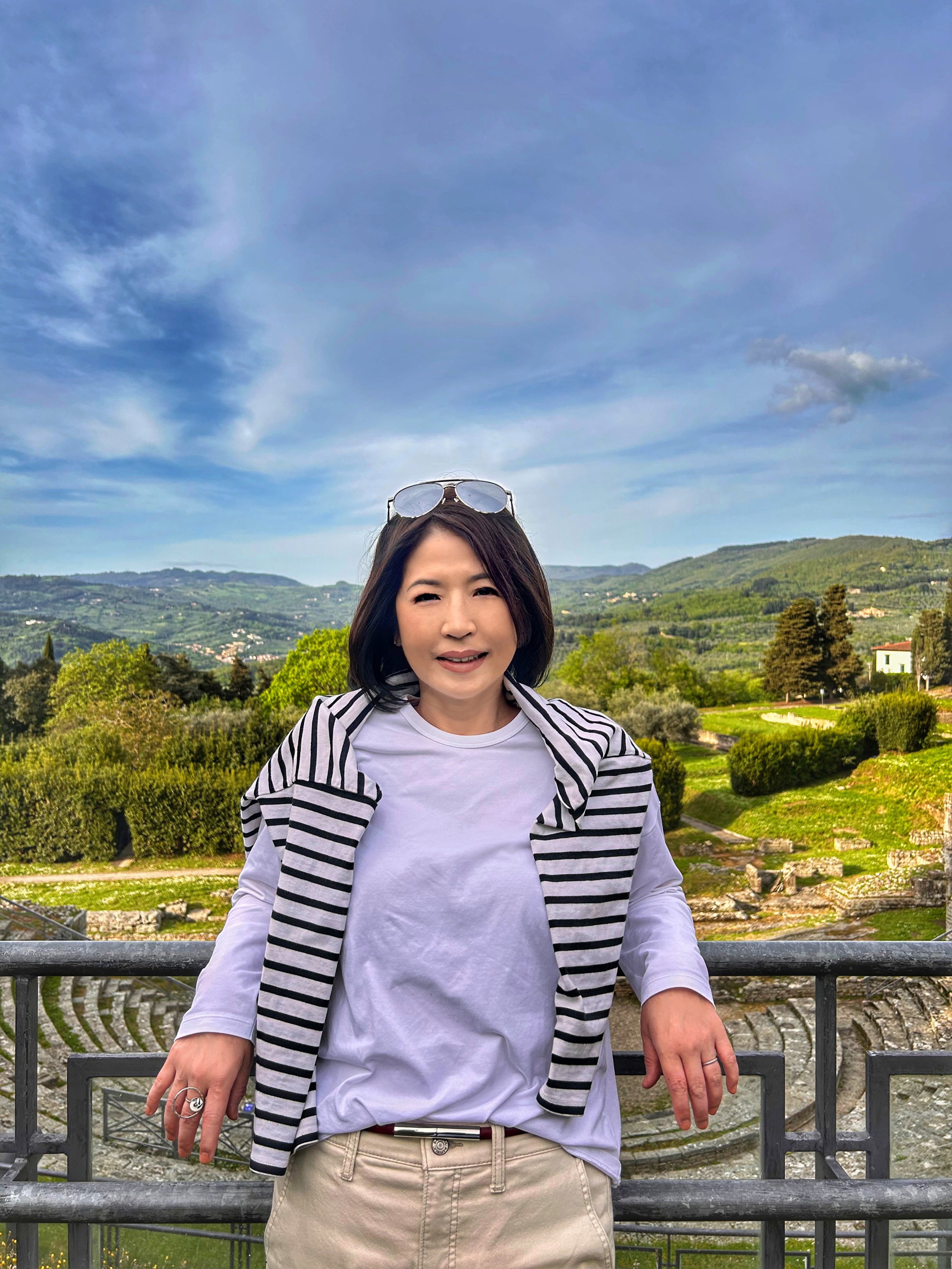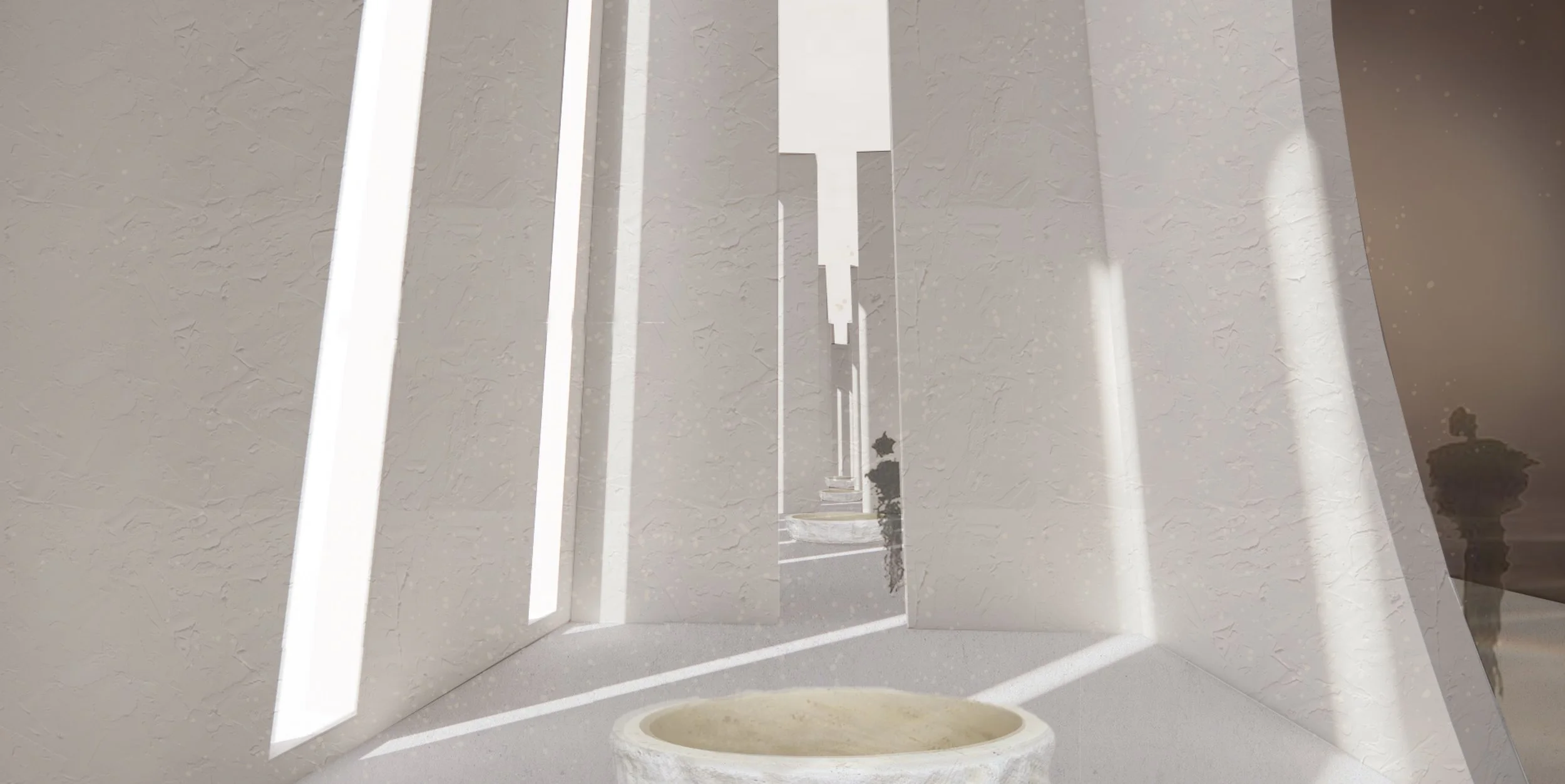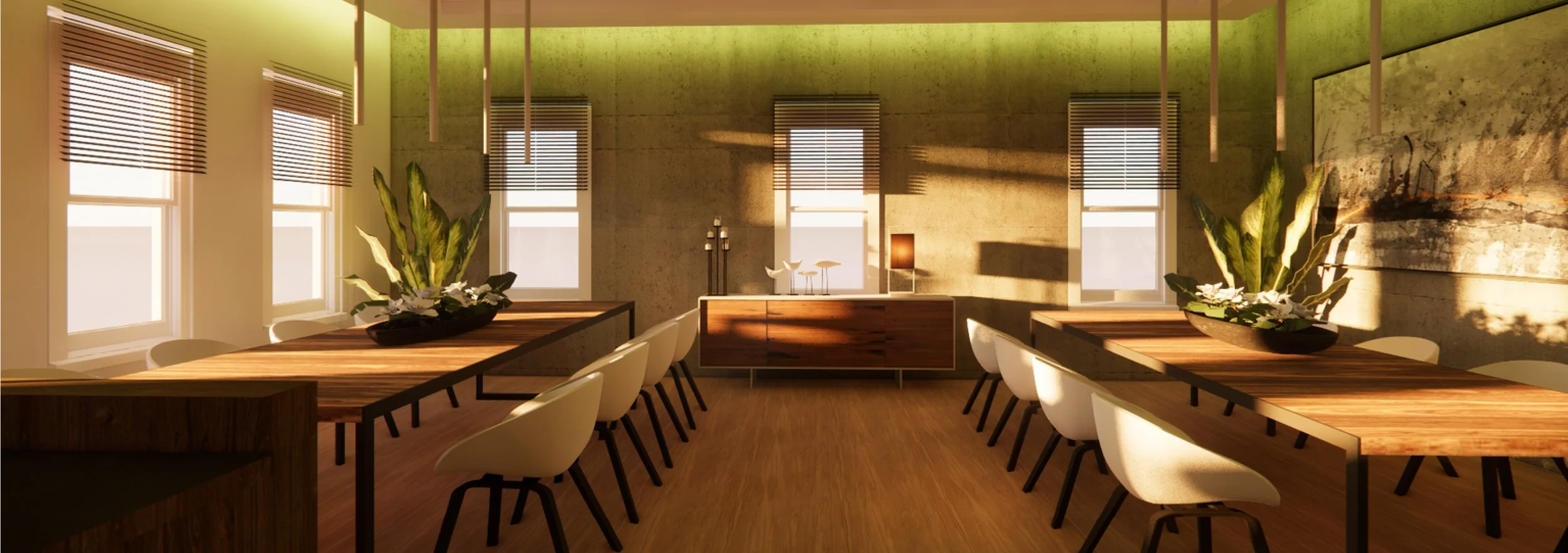Online Degrees Make Design Dreams Possible
An overview of distance learning at NYSID with student perspectives from Dorothy Hill, an AAS distance-learning student who was studying from Amsterdam, Netherlands; Nicole Hand ’25, a BFA distance-learning student who was studying from Denver, Colorado; and BFA distance-learning student Haruko Utsuki, who is based in Toronto, Canada, and took a semester abroad in Florence, Italy.
If you’re dreaming of studying interior design, there’s no better place than the New York School of Interior Design (NYSID). Architectural Digest has singled out NYSID for producing “critical thinkers who can look at design through social, cultural, and historical lenses.” But, for many prospective students, uprooting their lives for higher education in New York City is not an option. NYSID has some of the best online degree programs in the world, including a professional distance-learning BFA that has been accredited by the Council for Interior Design Certification (CIDA). “The clearest benefits to students of a CIDA-accredited program are an assurance that their education will be of the highest caliber, and that it will prepare them for the NCIDQ exam when combined with work experience,” says NYSID VP for Academic Affairs & Dean Dr. Ellen Fisher. NCIDQ certification is important for all designers, particularly those who hope to become licensed as professionals and lead interior design departments.
For online courses, NYSID gives students the option to take a DR section (“real-time” courses taught in Zoom with live interaction between the students and faculty); or a DL section (asynchronous online courses, with personalized feedback from faculty, which allow students to work on their own schedules). All of the courses are organized and run on the Canvas platform, the College’s learning management system. Prospective students need not worry about purchasing software to study. Freya Van Saun, NYSID’s director of blended and online learning, says, “All of the software systems come with the student package. Zoom, Adobe, and Microsoft Suite are integrated into Canvas so it’s a seamless experience for the student, just clicking a link. Canvas is rich with the ability to give video and written feedback with marked up projects. Programs such as AutoCAD and SketchUp are all supported in classes, and our IT staff are available to students.”
Van Saun contends that it’s NYSID’s online faculty, and the way they are trained, that makes the College’s online programs extraordinary. NYSID faculty are often the owners of successful design firms, including Amy Everard, Jeffri Boisvert, and Alejandra Munizaga, the online instructors praised by students in this article. Van Saun says, “Our teachers are committed educators with design careers, who teach because they choose to. To date, NYSID’s training of online faculty has been one-on-one. We take a very personal approach to supporting our online instructors because we are a small institution, and we want this same intimacy to translate into the classroom setting. We are trying to replicate the feeling of being in an in-person classroom in that we want the teacher to have ownership of what they are teaching and feel a direct engagement with individual students.”
Studying in NYSID’s online programs does not necessarily mean staying at home for the whole course of your degree. Students enrolled in distance-learning degrees can participate in travel study, come to New York to take an in-person course, and/or switch into an in-person program at any point in their academic journey. Indeed, many of NYSID’s online students are local to the New York metropolitan region. “We offer flexibility because we want to remove the obstacles that keep people from pursuing the design education they have always wanted,” says David Sprouls, president of NYSID.
Studying from Abroad & Managing a Difference Between Time Zones
Dorothy Hill (AAS)
Dorothy Hill, a native of Canada and Dutch citizen who was studying in NYSID’s online Associate in Applied Sciences in Interior Design (AAS) from Amsterdam, in the Netherlands, was previously a journalist for Bloomberg, and an investor relations and digital strategy executive for various European banks, before pursuing her degree at NYSID. It has always been her dream to buy and renovate a historical home in Italy. When she entered her 50s, she decided to blend her aspirations for a new career with the adventure of designing a home on Lake Como and eventually living in it. Hill was not ready to commit to a full degree, so she tried out NYSID by starting in the Basic Interior Design (BID) certificate program online and transferred into the distance AAS program because she found what she was learning, and how she was learning it, compelling. All NYSID’s undergraduate programs “stack” into each other, so if a student starts with the BID, they can apply credits to the AAS, and ultimately to the BFA, all of which are both offered in person and online.
Hill says, “The program works very well virtually.” The asynchronous (DL) online studios and electives have exceeded Hill’s expectations. “Because of the time difference between Amsterdam and New York, I took the asynchronous versions of the residential studios,” says Hill. “There were deliverables due for every module, and my professors would allow us to turn in work-in-progress during the week before the final submission at the end of the week. The teacher would make a video of herself with my project on screen and give verbal and visual feedback. The feedback cycle was really very effective.”
Her favorite courses thus far have been two studios in Residential Design I & II, and the Design Process course, taught by alum Alejandra Munizaga ’11 (BFA), principal of Natura Interiors. “The first half of the course was analyzing iconic houses from famous architects, examining why each architect made the design choices she did. For the second half, we reverse-engineered the design process and applied design decisions to a project, an artist’s studio in the woods,” says Hill. “Alejandra was organized, and the course was very clearly structured.”
Despite studying almost entirely asynchronously, Hill has made friends in the program. Freya Van Saun explains, “Even in the asynchronous classes, the teachers offer optional ‘open studios’ each week and students have the opportunity to be together in a real-time, relaxed, and unstructured forum.” This was Hill’s experience. “There are group calls, and you start to see the same people in numerous classes,” she says. “I have made some real friends and have contact with them outside of class. Like-minded people find each other. I appreciate that it’s a mix of career switchers and people fresh out of high school.” One of her American design-school friends has recently visited her in Amsterdam.
Getting a World-Class Degree from the Mountains of Colorado
At the time of this interview, Nicole Hand was a senior enrolled in the online BFA studying from Denver, and sometimes Silverthorne, Colorado, where she frequently skis. She was in the end stages of designing her thesis and gearing up for NYSID’s two-week travel study course to China, taught by Dr. Zhijian Qian, an expert in Chinese art and design.
Nicole Hand '25 (BFA)
In 2020, Hand, who has an undergraduate degree in psychology from the University of Maryland, lived in New York City and worked in recruitment for a private equity firm. The career didn’t feel like the right fit, especially since she was working entirely online from her New York City apartment during the pandemic. She took a road trip to Colorado and decided that she wanted to move there, where she had access to outdoor activities, and also that she needed to change her career. She says, “I did my research and quickly learned NYSID has a better reputation than many of the interior design programs out here.” NYSID’s online BFA meant she didn’t have to choose between her academic goals and the lifestyle she envisioned for herself. She says, “I’m thrilled with my choice to study online at NYSID. I have been really happy with the instructors, advisors, and staff. When I had a technological question or personal issue, such as breaking my arm while skiing, the people at NYSID helped me.” She’s been able to work part time, most recently as an in-store designer at CB2, while studying full time.
Hand has chosen synchronous (real-time) studios in recent years because she prefers them. “Generally, the format of these ‘live’ studios is that the first half is teaching and the second half is working,” Hand explains. “Each student gets a full 20 minutes to present work and receive feedback in what are called ‘desk crits.’ The teacher draws on your project on screen and talks about your work, and so do your peers.” She adds, “I have found that the ability to watch recordings of the ‘desk crits’ after the class is very helpful to my revision process.”
Hand has gotten a lot out of her teachers, many of whom are practicing designers. She took Architectural Woodwork Detailing and Kitchen and Bath with Jeffri Boisvert. She says, “These are very construction-document-heavy courses and Jeffri was excellent at teaching us how to draw the documents with precision. For example, we would have to draft all the cabinetry for a mudroom, so that we could communicate to the millworkers exactly what it was going to look like and how it was going to connect to the wall. One of the most useful things was that he did the projects alongside us and showed us his own process.” Another of her favorite courses was Contract Design III, a studio taught by Amy Everard, principal of Soft Landing Studio. In this course, Hand designed a Spina Bifida Clinic and a preschool that specialized in ADHD. She says, “Amy was so good at giving us resources to help us research and source very specific furnishings and materials, like hospital-grade doors and soundproof ceilings.”
Hand is culminating her NYSID education with a two-week travel study course in China, for which she received the Anne K. Duffy Travel Study Scholarship. Some of NYSID’s distance learning students get in-person experience with instructors and peers by participating in the college’s unique Travel Study programs. NYSID’s leaders believe that the best interior design education comes from a combination of classroom learning and getting out in the world to find inspiration in three-dimensional space and regional design traditions. NYSID offers students the chance to take ten-day to two-week travel courses over winter and summer breaks. The courses are taught by faculty members who have expertise in the design history of the region. For 2026, the Office of Academic Affairs is planning travel-study courses to destinations in Southern India (over winter break) and possibly Spain, Morocco, and New York, USA (in late spring). For those who want the full study abroad semester experience, NYSID also offers a spring semester program in Florence, Italy, for undergraduates, in partnership with the Santa Reparata International School of Art (SRISA).
From Distance Learning in Toronto to a Semester Abroad in Florence!
Haruko Utsuki (BFA)
Haruko Utsuki, a student in NYSID’s online BFA, is a Canadian citizen based in Toronto, who was taking NYSID’s semester abroad in Florence, Italy, at the time of this interview. She spent decades working as a corporate translator and the assistant to the president of Honda Canada as she prepared to put her children through college. When she started in NYSID’s distance learning BFA in 2023, she was still working full time in a 9-to-5 job, so she required maximum flexibility, and she studied part time. “One of the things that drew me to NYSID was their sensitivity to career changers,” she says. “I was told from the start that I could switch from the online to in-person degree at any time. This was an indication of inclusiveness, and it encouraged me to try to pursue my dream. My studies have been successful because the program is so flexible.”
For her first years at NYSID, Utsuki took a combination of synchronous (DR) and asynchronous (DL) design courses from a distance. “Synchronous and asynchronous studios worked equally well. The professors were very responsive to email, and quick to get back to you. The video feedback on each project was helpful. Those are the things that made online learning successful.”
Utsuki remained in her full-time job as she studied, until she saw an email from the Office of Academic Affairs announcing a merit-and-needs-based scholarship opportunity for the study abroad semester in Florence. She had always felt an affinity with Italian design because she was born in Japan and is drawn to the combination of the traditional and contemporary in design. When she heard that she had received the scholarship, she took it as a sign, resigned from her job, and decided to commit to a future in interior design, the profession she had always dreamed of. She enrolled full time in the BFA and traveled to Italy.
Every spring, NYSID students take their studio and technology courses with an onsite NYSID instructor or online, while SRISA instructors teach the electives. In her semester in Florence, Utsuki has had an opportunity to take an in-person Residential Design studio with NYSID instructor Warren Ashworth, who challenged her to design an apartment in the footprint of the Sant‘Orsola convent constructed in the 14th century, which they visited. Says Utsuki, “Studying in person with Mr. Ashworth and getting to know him well has been great. He shares many of his experiences as an architect and interior designer with us, and this enriches the course.” She adds, “I am taking an elective in History of Italian Design with a local SRISA historian and instructor. It’s amazing because I am hearing the history of Italian political struggles while seeing how design mirrors the way a country changes.”
She says, “The combination of studying online, and then studying abroad in Florence, has developed me as a designer in a very positive way. Seeing the different ways people live makes me think about having a solid reason for every design choice I make. I question why I might want to apply this style, object, or color, and how it relates to history and culture. This has made me a better designer.”
The Next Phase for Online Learning at NYSID
Freya Van Saun has discovered that the digital-learning format provides a unique opportunity to diversify expertise and bring more than one teacher into a digital course. “Faculty are always trying to figure out how to improve the courses,” she says. “There is ongoing faculty engagement and collaboration in how the courses are built. Our online courses are not robotic and static. They evolve. We are currently looking at a way to bring in multiple faculty voices in a digital format, to let each professor talk about what they’re passionate about. There will be a central instructor, but also short videos and guest sessions with other experts. This will make the courses even better.”





















